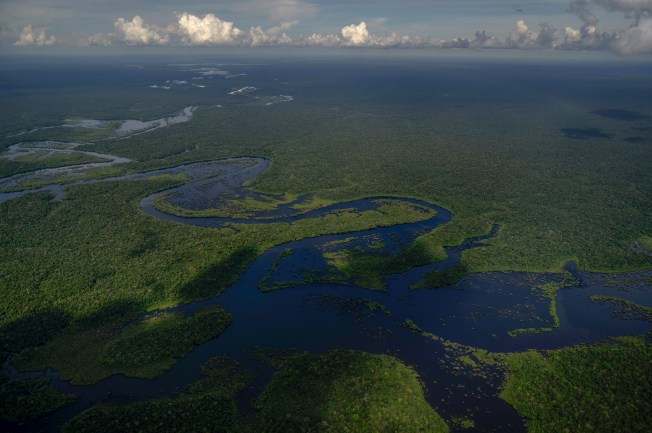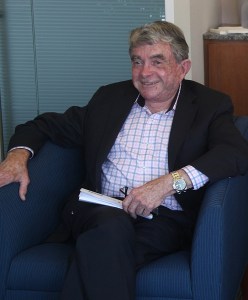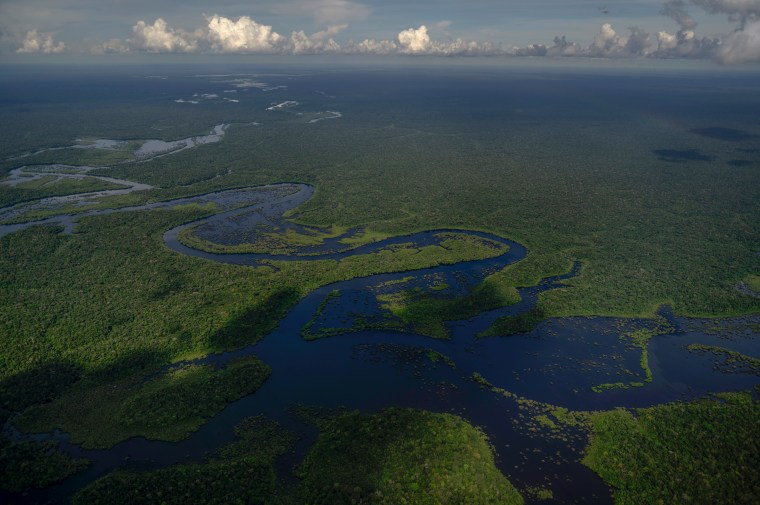Covering the Amazon: Q&A with Renata Neder, CPJ’s Brazil representative

Environmental reporting can be dangerous and traumatic for journalists. Whether covering wildfires or flash floods or reporting from remote areas where there is environmental destruction or drug trafficking, journalists face numerous threats on the beat. We spoke with CPJ’s Brazil representative, Renata Neder, about the recent murders of British freelance journalist Dom Phillips and Indigenous issues expert Bruno Pereira to find out how CPJ can continue to demand justice in their cases, as well as equip journalists with the tools they need to continue safely reporting on the risks facing our planet.
Dom Phillips and Bruno Pereira—who was traveling with him—were shot and killed the morning they went missing in early June while they were on a reporting trip in the Brazilian Amazon. Could you tell us a little more about what happened and what CPJ is doing to demand justice?
Dom Phillips and Bruno Pereira were murdered during a reporting trip in the Javari Valley, a region deep in the Amazon forest and near the triple border of Brazil, Colombia, and Peru. They went missing on June 5 and their remains were found 10 days later. The Amazon’s Javari Valley, where Phillips and Pereira were killed, is known as a drug trafficking route where illegal activities like logging, fishing, and mining thrive, posing a threat to local Indigenous communities and the environment.
Brazilian authorities’ search efforts to find Phillips and Pereira during the first days of their disappearance were reportedly slow and insufficient. The intensive media coverage, international mobilization, a federal court order, the creation of special oversight commissions in Brazilian Congress and of a working group in the National Justice Council were crucial in pressuring authorities to respond to their disappearance and investigate this brutal murder.
In July, a federal prosecutor charged three men with the murder and in August the police arrested another five people suspected of involvement in the crime. Phillips and Pereira were in the Javari Valley to interview local residents, Indigenous groups, and people defending the Indigenous territory from illegal fishermen and other outsiders for a book that Phillips was writing.
Since the day Phillips’ disappearance became public, CPJ has repeatedly called on the authorities to expand search efforts and thoroughly investigate the case to identify all of those involved in the killing and the motivation behind the crime. CPJ worked together with a group of other Brazilian and international press freedom groups urging immediate action and thorough investigations, and held meetings with the Federal Police and the House of Representatives’ special oversight commission.
Although three men have been charged with their murder, authorities must continue to thoroughly investigate the case and get to the bottom of what happened, identifying all those behind Phillips and Pereira’s murder, including the masterminds.
The fight for justice is a marathon, not a sprint. A case can take too many years in court. CPJ will continue to closely monitor the developments of the case, remain vigilant, and mobilize to demand full justice.
In 2020, according to a report from environmental organization Global Witness, 20 environmental activists were killed in Brazil, and nearly three quarters of recorded attacks took place in the Amazon region. Why is it dangerous to defend the forest and what are the threats to journalists reporting on the Amazon?
The Amazon is the world’s largest tropical rainforest, covering 5.5 million square kilometers [2.1 million square miles] of land across at least eight different countries in South America. But the forest, one of the most biodiverse places on earth, is under attack, suffering from deforestation, intentionally set fires, land grabbing, and the impacts of illegal mining, logging, fishing, and cattle breeding. In addition, there are drug trafficking criminal organizations operating in the Amazon and several reports have revealed connections between drug trafficking and environmental crimes in the region.
Add to this context the recent years’ dismantling of environmental protection policies and overall impunity in terms of environmental crimes and you have a recipe for disaster. The Amazon is under attack and so are the people fighting to protect it.
When journalists use their voices to denounce environmental crimes and the destruction of the Amazon forest, they are exposed to a complex context of violence over land and natural resources that leaves dozens killed every year in Brazil. As Brazilian journalists recently told CPJ, “covering a lawless land is risky.” From subtle warnings and whispered threats to brutal intimidation at gunpoint, direct open threats, and violent attacks, journalists face elevated risks for their environmental reporting.
In Brazil and beyond, the environment is a dangerous beat for journalists. What are the challenges to environmental reporting in the Amazon and how can journalists mitigate them?
In Brazil, CPJ had documented cases of journalists harassed by a mining company, threatened after covering intentional fires in the Amazon, and targeted with cyberattacks, threats, and an attempted break-in. The environment is also a dangerous beat for journalists reporting in Guatemala and other parts of the world. In addition to safety concerns, journalists reporting from the Amazon face logistical challenges in terms of communication, accessibility, weather, and transportation.
In times of record high deforestation and increasing conflict over land and natural resources in the region, covering the Amazon is crucial, but it is expensive and risky. With that in mind, CPJ has recently published a safety advisory for journalists covering the Amazon with advice about pre-assignment planning, logistics, health, equipment, and digital security. CPJ also published a summary of key safety steps.
Spotlight on Giving: Remembering Burl Osborne

Journalist and publisher Burl Osborne, who died in 2012, came from humble beginnings in the hills of Appalachia. Diagnosed at a young age with kidney disease, Osborne overcame a number of medical challenges to build a successful career as a journalist and a staunch defender of the free press.
Osborne began his career as a local Associated Press reporter in West Virginia whose stories gained national attention and later became the editor and publisher of The Dallas Morning News, as well as chair of the board of The Associated Press.
Osborne was also an early director of the board of CPJ and was integral to the creation of CPJ’s endowment fund, which continues to sustain our work and mission.
“Burl served on the board of CPJ for fifteen years,” former executive director Joel Simon says on the back cover of Osborne’s just-released biography. “He had an uncanny ability to identify the key issues, ask the relevant questions, and build a consensus around an informed decision. It was a marvel to watch him work.”
Those words were echoed by Paul Steiger, founding editor-in-chief, CEO, and former president of ProPublica–who served as the chair of CPJ’s board during Osborne’s tenure.
“I remember Burl with great affection, admiration, and respect,” Steiger told CPJ, “He was a terrific journalist and news executive, and a wise colleague whom I found to be a brilliant collaborator.”
In reflecting on the decade since Burl’s passing, Steiger cited his “marvelous knack for anticipating problems before they had a chance to emerge. When he spoke, everyone in the room listened.”
This year, following the 10th anniversary of Osborne’s death and the release of his biography by author Jane Wolfe, his wife Betty donated a special gift in memory of her late husband.
“There’s so much going on in the world where journalists are beat up, kicked around, criticized, kidnapped and killed,” Betty Osborne told CPJ. “Maybe some of the people who read Burl’s story will help try to change that attitude.”
That story, “Burl: Journalism Giant and Medical Trailblazer,” released on September 6 by Andrews McMeel Publishing, catalogs Osborne’s journalism career and his wisdom at a time when such acumen is needed to combat distrust of the media in the United States.
When Wolfe began writing the book, “terms such as ‘fake news’ and ‘alternative facts’ had come into the vernacular, and then-President Donald Trump was leading the charge against the media, calling reporters ‘corrupt liars’ and ‘the enemy of the people,’” Wolfe told CPJ.
“I wanted the people who were attending Trump rallies and attacking the press to know all about Burl, a paragon of integrity, the opposite of ‘the enemy of the people.’ He represented all that is good about reporters and editors and publishers. He was such a stickler for honesty, fairness, and accuracy.”
The world is better off because of that commitment to honesty, fairness, and accuracy–and with Betty’s wonderful gift in Osborne’s memory, his legacy of defending a free press will continue through our work.
Must-reads
One year after the Taliban’s takeover of Afghanistan, CPJ released a special report on the ongoing media crisis across the country. “Female journalists face particular challenges, including intimidation, lack of access to information, and severe discrimination,” Zahra Joya, who founded the news agency Rukhshana, which covers the lives and concerns of Afghan women, wrote in an article for the report.
CPJ spoke with reporters in the U.S. concerned about threats–both online and legal–in the fallout from the Dobbs decision, which overturned Roe v. Wade. “Things just feel a little more charged than they have previously,” Becca Andrews, a journalist for Mother Jones, told CPJ. “I’d like to say it all [the threats to advocates and sources] doesn’t have a chilling effect… but it’s messy.”
CPJ published a briefing on the climate of impunity in Mexico by Natalie Southwick, CPJ’s Latin America and the Caribbean program coordinator, and Carlos Martínez de la Serna, CPJ’s program director. “One bright point in this press freedom crisis,” they write, “has been the efforts from journalists and citizens to come together, protest violence against journalists, and call for the Mexican government to do more to ensure security for reporters under threat.”
CPJ in the news
“I Was Onstage With Salman Rushdie That Day, and What I Saw Was Remarkable,” The New York Times
“A Nefarious and Hidden Threat to Journalists Rises,” Columbia Journalism Review
“Family of Palestinian American Journalist Demands Justice,” VOA
“Threats to free press are multiplying around the world,” CNN
“Rights groups condemn Hezbollah threats against Lebanese journalists,” Arab News
“Six months of Ukraine — the toll on journalists and journalism,” EUObserver
“Austin Tice: Syria denies holding US journalist captive,” Middle East Eye
“Ethiopia Gets Tough on Journalists Since Tigray Conflict,” VOA
“Uzbekistan admits CPJ representative after 5 hours of wait in airport,” AKIPress
“Poland Summons Belarus Diplomat Over Jailing Of Journalist,” The Associated Press
